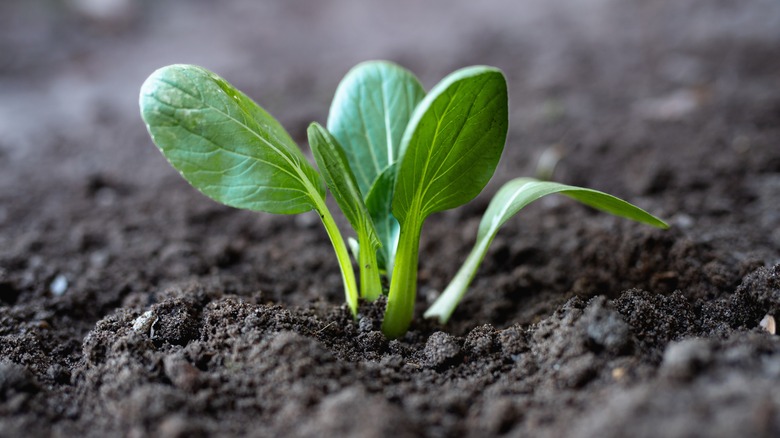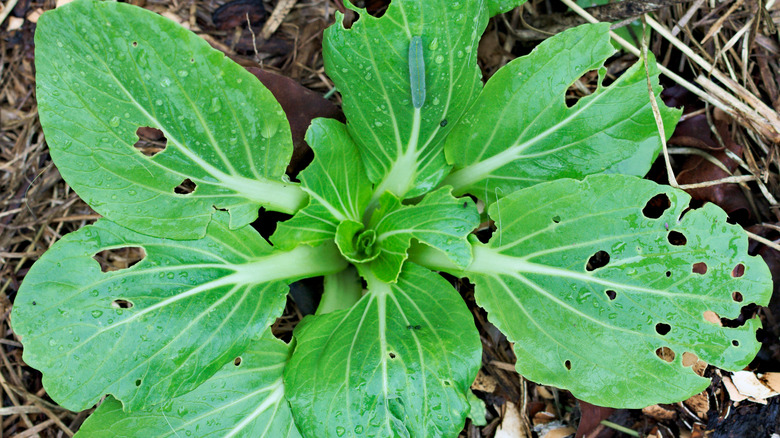TikTok Shows Us How To Successfully Grow Bok Choy From Seed For A Tasty Harvest
TikTok is here to show us how easy it is to grow bok choy from seeds in just a few short weeks. To do so, you'll need a plastic or aluminum container, seed-starting soil, bok choy seeds, and plastic wrap. Begin by selecting a container with drainage holes to prevent waterlogging, or poke your own holes into a sealed container. Fill it with a well-draining potting mix that's rich in organic matter, like compost or aged manure. The TikTok video recommends 2 parts soil, 1 part compost, and ¼ part sand. This will provide the necessary nutrients for healthy growth.
Plant the bok choy seeds about ¼ inch deep in the soil, spacing them a few inches apart to allow room for growth, and cover them lightly with soil. Keep the soil consistently moist but not waterlogged, as bok choy prefers evenly moist conditions. Cover the top of the container with plastic wrap to seal in the moisture, which will create a humid environment for the seeds to germinate. Place the container in a shaded area that only receives indirect sunlight for 2 days.
You should notice that the seeds will germinate in a few days, so be sure to keep them moist. On day 12, you can remove the plastic wrap and shift the container into full sun. As the seedlings emerge, you may want to thin them out to maintain proper spacing, leaving the strongest ones to grow. Continue to water regularly, keeping the soil consistently moist.
Benefits of growing bok choy from seed
Growing bok choy from seed offers several benefits, making it an excellent addition to your garden. Starting from seed provides you with greater control over the entire growth process, from germination to harvest. This control ensures that the plants receive the best care possible, leading to healthier and more productive crops. Another benefit is the wider selection of varieties available when growing from seed. Nurseries and seed catalogs often offer a diverse range of bok choy cultivars, allowing gardeners to choose varieties that suit their preferences and growing conditions. From traditional varieties to more unique hybrids, the options are plentiful, providing opportunities for experimentation and culinary exploration.
Furthermore, growing bok choy from seed can be more cost-effective than purchasing seedlings or mature plants. While an initial investment in seeds and growing supplies is required, the overall expense is typically lower compared to buying established plants. Additionally, by saving seeds from mature bok choy plants, you can reduce costs even further in subsequent growing seasons.
Starting your vegetables from seed also offers the satisfaction of witnessing the entire lifecycle of the plant, from tiny seeds to robust harvest-ready specimens. This process can be educational and rewarding, especially for beginner gardeners or those interested in learning more about plant propagation and cultivation. Eating your own vegetables that you have nursed and cared for from seed can provide deep satisfaction and pride in the hard work that you've invested in your garden.
Common issues with growing bok choy
Like growing any crop, growing bok choy from seeds can encounter several common issues that may hinder successful germination and growth. One common problem is poor germination rates, which can be caused by factors such as old or low-quality seeds, incorrect planting depth, or unfavorable environmental conditions. To overcome this, it's important to use fresh, high-quality seeds and ensure they are planted at the correct depth — about ¼ inch deep.
Another issue is damping off, a fungal disease that affects seedlings, causing them to wilt and die. Damping off often occurs in overly moist or poorly ventilated conditions. To prevent damping off, use sterile soil and containers, avoid overwatering, and ensure proper air circulation around the seedlings.
Seedling legginess is another common issue, characterized by thin, elongated stems and weak growth. Leggy seedlings typically occur when plants are grown in low-light conditions or when the light source is too far away from the seedlings. To prevent legginess, provide adequate light by placing seedlings under grow lights or in a sunny location. Keep the lights close to the seedlings, adjusting the height as they grow to maintain optimal distance.
Lastly, bok choy may be susceptible to pest infestations, such as aphids, flea beetles, or cabbage worms, which can damage foliage and stunt growth. To combat garden pests, regularly inspect plants for signs of infestation and use organic pest control methods such as insecticidal soap, neem oil, or introducing beneficial insects like ladybugs.

